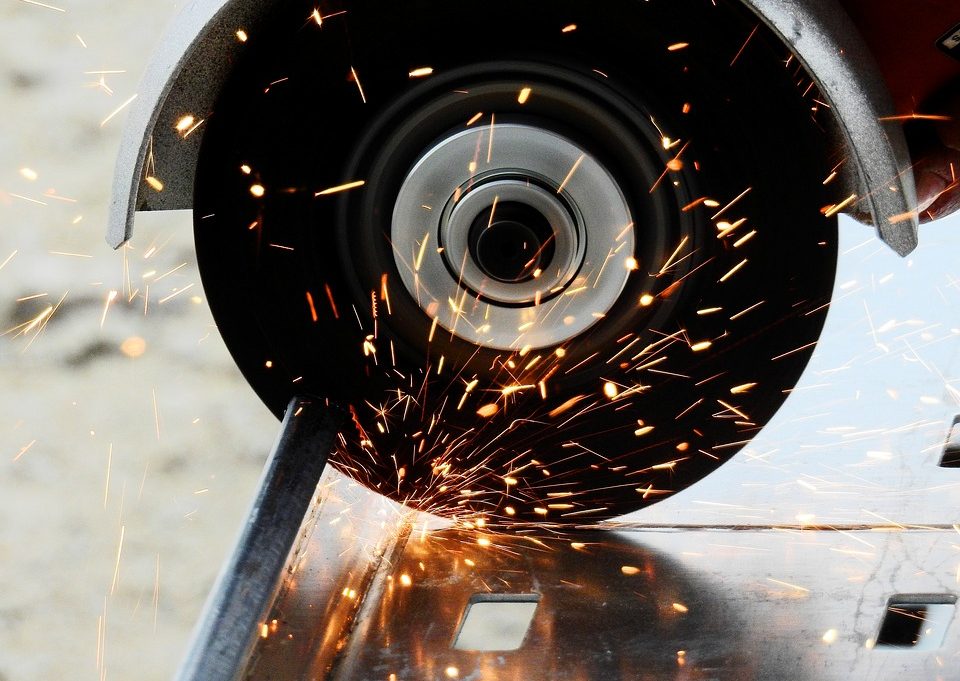Angle Grinder Safety: Tips to Reduce the Risk of Angle Grinder Injuries
Some of the risks to be aware of while using angle grinders include the following:
- sudden kickback
- flying debris
- working near combustibles/flammables
- noise exposure
- repetitive strain injury
You can prevent the above factors by doing the following:
- following safety procedures
- becoming familiar with the product’s safety features
- using additional safety accessories
Follow Safety Procedures for Angle Grinders
The first step in using an angle grinder safely is to follow basic safety procedures. This includes wearing the appropriate personal protective equipment (PPE), such as the the following:
- hearing protection
- safety glasses
- face shield
- gloves
- flame-resistant shirt
- protective foot wear
PPE is important for the operator’s safety as well as the safety of those working around him or her.
Safe Environment
In addition, make sure to check the environment to ensure it is safe for angle grinding. A clean, dry and well-lit environment helps prevent tripping and electrocution hazards. Never perform angle grinding near combustible liquids, gases or dust. Safeguarding the equipment also includes eliminating distractions, which are a significant cause of injuries. When possible, turn off or remove cell phones and other distracting devices from the area where you perform angle grinding.
Furthermore, operators must make sure they are physically capable of working an angle grinder. If the operator is tired, he or she needs to take a break. Also, don’t perform angle grinding under the influence of substances.
Proper Tools
Following angle grinder safety procedures also includes using the right tools for the job. When working with unique applications, a specialized tool might be necessary. For example, when working in tight spots, a die grinder with a flexible shaft, or possibly a flat head grinder, might be a better option than an angle grinder. When starting work, operators need to be able to answer the following questions to ensure proper tool selection:
- Is a slicer or a grinding wheel needed?
- Is the right guard installed on the grinder?
- Does the grinder size match the grinding or slicer wheel size?
- Does the maximum rpm of the grinding wheel match up with the maximum rating of the grinder?
- What direction is the wheel spinning?
When it comes to angle grinder safety, the appropriate guard also needs to be between the spinning accessory and the operator. The majority of grinders come with a Type 27 guard. However, when using a Type 1 wheel (a flat cut-off or slicer wheel), a Type 1 wheel guard must be in place. This is an ANSI (American National Standards Institute) standard often overlooked by operators. There are a few choices available when it comes to Type 1 guards. You can purchase a full-metal, Type 1 guard, or some manufacturers have a clip-on option that converts their Type 27 guard into a Type 1 guard.
Become Familiar with Your Angle Grinder’s Safety Features
The majority of manufacturers have engineered corded and cordless angle grinders with a series of safety features. These features help manage and control the tool to protect the operator and others around them.
Slip Clutch
One such feature is the mechanical slip clutch, which absorbs the forces that create kickback. Kickback is one of the most common hazards. It occurs when the wheel comes to an immediate stop.
For instance, if the wheel binds to the material you are cutting or if the tool loses power. As a result, the clutch helps keep the operator in control of the grinder. Additionally, it significantly reduces the risk of the accessory shattering and producing flying debris, which can occur with cutting wheels.
Mechanical Safety Brake
Another safety feature available on grinder is a mechanical safety brake. This can stop a slicer wheel in less than a 1 s and a grinding wheel in less than 2 s when the grinder’s switch is disengaged. If the operator loses control of the tool, this safety feature helps prevent a serious injury from happening by stopping the wheel quickly.
Auto-Balance and Anti-Vibration Features
Grinders that have an auto-balance feature and an anti-vibration handle are also crucial for injury prevention. Operators typically work with their power tools for hours at a time. After working with an angle grinder, they might feel tingling in their arms and hands. Over time, this can cause permanent nerve damage referred to as repetitive strain injury (RSI). Another condition that can develop after long-term use is hand-arm vibration syndrome (HAVS). This is also known as white finger syndrome. HAVS is a permanent and potentially debilitating disease. It causes a restriction of blood flow to the hands and arms, resulting in pain and numbness.
Using a grinder that has auto-balance and anti-vibration features significantly reduces the vibration that transfers from the tool to the hands and arms. An additional benefit of the auto-balance features is that it increases the life of the tool and wheel.
Drop-Secure
Another critical safety feature is a drop secure, which reduces injuries from accidentally dropped tools. A 6.5-lb angle grinder dropped from 30 ft can strike with more than 600N of force.
Therefore, having a drop-secure feature on the grinder is an easy way to prevent serious injuries. Some tools are also have a tethering on the rear of the tool. This allows for the attachment to a lanyard.
Use Accessories to Enhance Angle Grinder Safety
When performing angle grinding always utilize the accessories that are provided at the time of purchase. These accessories include such as the guard and side handle. Review the accessories that come with the tool and make sure you understand the purpose of the accessories. Also, you must install and use the hand that is provided during operation. It is also crucial to never alter the tool. For instance. some users remove the handle because they feel it gets in the way. If this is a frequent issue, you can purchase a multi-position handle that offers many options for positioning the handle.
Vices and Clamps
Another overlooked point in angle grinder safety involves securing the work. This requires using proper vices and clamps, which keep the work-piece safely in place, preventing additional hazards such as over-reaching.
When using a grinder, it’s vital that operators position themselves in an athletic stance that feels and comfortable and well-balanced. Therefore, they don’t have to over-reach or take a hand off the tool. In addition, this ensures they are ready in case of unexpected binding.
Extension Cords
It is also important to use an extension cord of proper gauge and length. Depending on the amp rating of the tool you are using, this will vary. Refer to the owner’s manual for recommendations, or the operator can call the manufacturer if they are unsure.
When changing accessories on a grinder, it’s imperative to unplug (or if it’s cordless, disengage the battery from) the tool. Therefore, the tool doesn’t unexpectedly turn on. Many users don’t consider the electric plug they are using or even the extension cord. However, make sure to check all electrical cords to prevent injuries. Additionally, never alter the manufacturer’s plug. This may cause electrocution as well as void the manufacturer’s warranties.
Grinder Wheel
Inspect all accessories, particularly the grinder wheel, for chips, imperfections or cracks before installing them on your grinder. A small crack in a grinding or slicer wheel can result in shrapnel flying before the operator realizes something is wrong. After visually inspecting the wheel, run the wheel at no-load, down and away from the operator and others, for 60 s test the wheel’s integrity. If the operator feels the wheel has any unusual vibration, it’s time to replace the wheel. Make sure to discard the current wheel as well.
Conclusion
Being knowledgeable on how to identify and mitigate the risks associated with using angle grinders and power tools will help reduce the possibility of injury. In addition, operators must follow safety procedures, use their tool’s safety features and take advantage of safety accessories.
Furthermore, the operator needs to follow their company’s safety management rules. Also, always remember to expect the unexpected while using angle grinders and other power tools. Following this straightforward rules allows the user to greatly reduce the risk of injuring themselves and others. Therefore, it will help to increase angle grinder safety.
Source: aws.org


